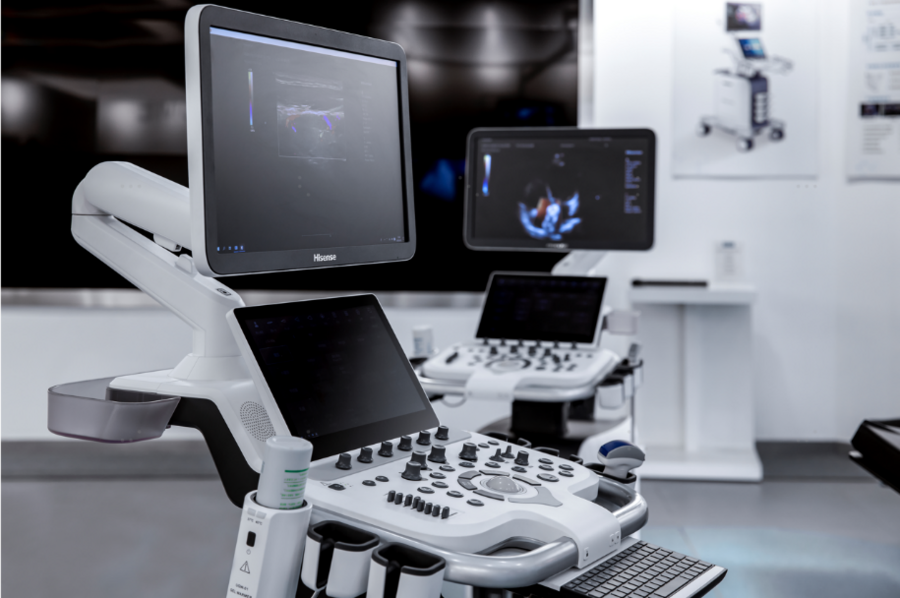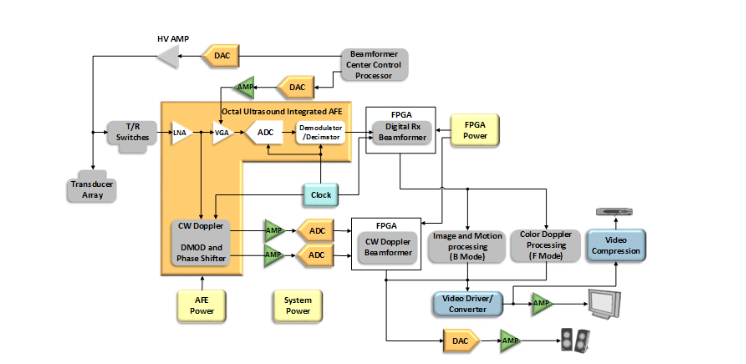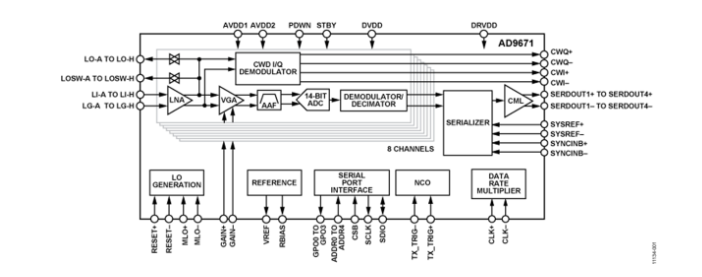
Ultrasound refers to sound waves with frequencies higher than 20,000 Hertz, which have specific applications in industrial and medical fields. With the progress of medical technology and the continuous update of equipment, ultrasound has become an indispensable application technology in the medical field. Medical ultrasound equipment mainly uses the signal or energy properties generated by ultrasonic feedback to different parts of the human body to diagnose or treat abnormal states or diseases of the human body.
At present, the most widely used field of medical ultrasound is the use of ultrasound technology for diagnosis, mainly through ultrasonic beam scanning human body parts imaging, that is, through the reception and processing of reflected signals to obtain images of internal organs. With the real-time movement of the probe of medical ultrasound equipment to obtain the specific image of the patient's internal organs, it can provide a comprehensive scan of the surface, abdomen, heart, obstetrics, urinary, musculoskeletal, etc., which is a common diagnostic method for soft tissue examination.

Digitalization and miniaturization is one of the main trends of medical ultrasound. The traditional trolley type, large probe ultrasound equipment is huge and expensive, and now the miniaturized ultrasound equipment in the market has been updated and developed, while ensuring clear images and high resolution, not only more complete functions, but also more diversified probes. These new small equipment can better meet the needs of clinical departments in hospitals, primary medical markets, out-of-hospital disaster first aid and other scenarios, and reduce the difficulty of medical workers.
Many manufacturers at home and abroad are promoting the above trend, some of which are commonly perceived in the industry, such as Sub Beamformer (Sub Beamformer), which can be placed in the probe of the device, Ultralow Power (Ultralow Power), which is sensitive to temperature and requires extremely low power consumption. And Wireless Connection, which is of general interest in the industry.

In addition, another development direction of medical ultrasound is high performance, which is also the common direction of global medical ultrasound efforts. On a large scale, in recent years, domestic manufacturers are gradually integrating with international manufacturers in this direction, but there is still a gap between international top applications in key areas such as cardiology, such as higher image quality, more comprehensive functions and better processes.
From a technical point of view, higher image quality means lower noise, higher signal-to-noise ratio (SNR), and higher signal-to-noise ratio puts higher requirements on the number of channels, from the previous 32, 64 channels to 128 or even 256 channels. In recent ten years, the simulation performance of the whole receiving end has not been greatly improved, although the linear transmission and increasing the number of channels can bring certain effects, but at the same time, the multi-wave number also means that the data amount of the Beamformer is getting larger and larger, so Software Beamformer is also a trend in the pursuit of high performance.
ADI's medical ultrasound solutions
Throughout the medical ultrasound industry, ADI is well known for providing low-noise, low-power analog front ends, precision amplifiers, converters, and power supplies. As you can see from the architecture diagram of the ultrasonic total solution below, excluding non-chip manufacturer products such as Transducer and FPGA Beamformer, ADI's products cover almost the entire ultrasonic system, including the transmit link, the receive link, etc. The following will introduce ADI related representative products and solutions from the aspects of transmit link, receive link, clock and power management in turn.

The launch part currently has two methods on the market: the first is the Pulser + Beamformer way, and the second is the linear launch mentioned above. The two architectures are different, the former is mainly used to generate a high-voltage pulse to drive the probe, the latter architecture is based on the DAC + Beamforme also added a high-voltage amplifier.
Over the years, Excelpoint, a technology licensed agent who has worked with ADI for more than 30 years, has built on ADI's portfolio of products and solutions to create a number of solutions close to customer application needs and gained market recognition. For the two modes of transmission link, World Health combined with the current market focus on MAX14815 and AD9106.
The MAX14815 is a highly integrated eight-channel 5-stage high-voltage ultrasonic transmitter (pulse generator). The pulse generator generates high-frequency, high-voltage bipolar pulses that are used to drive a piezoelectric sensor in an ultrasonic system through two pairs of independent high-voltage power supplies. Each channel can transmit up to 200Vpp, has up to 2A current capability, and integrates 2A active clamp (return to zero). Programmable current capability as low as 0.4A.
The embedded digital resources (SRAM and state machine) that the transmitter can use to control the pulse generator support transmit beamforming, significantly reducing the number of interconnects and the number of FPGA I/ OS. The embedded digital resources are programmed via high-speed serial interfaces and support complex emission technologies such as PWM for burst shaping and apodecing for beamshaping.
The MAX14815 also integrates eight independent low-noise, low-impedance active T/R switches. The T/R switch can be configured externally to support receive multiplexing, where the number of receive channels used is less than the number of transmit channels. The device can also be controlled by an external digital source (FPGA) via a traditional dedicated CMOS logic input. In addition to ultrasound medical imaging, the product is also used in high-voltage sensor MEMS drives, ultrasonic industrial applications (NDT), etc., to simplify portable ultrasound system design and save power consumption.

The AD9106 TxDAC and Waveform Generator is a high-performance four-channel digital-to-analog converter (DAC), a 12-bit output, up to 180 MHz host clock sine wave generator, with 24-bit tunable words, supporting 10.8 Hz/LSB frequency resolution, integrated on-chip mode memory for complex waveform generation. Features a direct digital frequency synthesizer (DDS).
The waveform generator has a single frequency output for all four Dacs, and a built-in mode control state machine allows the user to program the mode period for all four Dacs as well as the intraperiodic start delay for each DAC channel signal output. The SRAM data may contain a directly generated memory waveform, an amplitude modulation mode applied to the DDS output, or a DDS frequency tuning word.
The AD9106 offers excellent AC and DC performance and supports DAC sampling rates of up to 180 MSPS. Its SPI interface is used to configure the digital waveform generator and load the mode into the SRAM to gain and offset the digital signal as it is transmitted to the four Dacs. The device has a flexible operating power range (1.8V to 3.3V) and low power consumption, making it ideal for portable and low-power applications.

For ADI receiving link products, World Health combined with the current market focus to recommend the AD9671 dedicated to support medical ultrasound applications, designed for low cost, low power consumption, small size and ease of use. It has built-in 8-channel variable gain amplifier (VGA), low noise preamplifier (LNA), CW harmonic suppression I/Q demodulator with programmable phase rotation, anti-aliasing filter (AAF), analog-to-digital converter (ADC), and digital demodulator and extractor for processing data and reducing bandwidth.
Each channel of the integrated digital demodulator features a gain of up to 52 dB, a fully differential signal path, and an active input preamplifier terminal, optimized for high dynamic range and low power consumption for applications requiring small packages. In addition, LNA has a single-ended differential gain and can be selected by SPI. In CW Doppler mode, each LNA output drives an I/Q demodulator with independently programmable phase rotation and 16 phase Settings.
Each channel of the AD9671 can be entered separately into power-saving mode to extend battery life for portable applications, and the standby mode can be used to quickly power up for startup and restart. When operating in CW Doppler mode, VGA, AAF, and ADC all enter power-saving mode. Various features, such as a programmable clock, data alignment, and the generation of programmable digital test codes, are built into the ADC to provide greater device flexibility and lower system costs.

The AD9528 is a key ADI clock product recommended by WorldHealth in conjunction with the current market. It is a two-stage PLL, JESD204B/JESD204C integrated SYSREF generator that can be used for multi-device synchronization. The first phase locked loop (PLL) (PLL1) regulates the input reference voltage by reducing the jitter of the system clock. The second stage PLL(PLL2) provides a high frequency clock that enables lower integral jitter from the clock output driver as well as lower broadband noise.
The external VCXO provides the low noise reference voltage required by PLL2 to meet demanding phase noise and jitter requirements for acceptable performance. The on-chip VCO tuning frequency ranges from 3.450 GHz to 4.025 GHz. The integrated SYSREF generator outputs single, n-times, or continuous signals and synchronizes with PLL1 and PLL2 outputs to align the time of multiple devices.
The AD9528 produces six - and eight-channel outputs with maximum frequencies of 1.25 GHz and 1 GHz, respectively, each of which can be configured to output directly from a PLL1, PLL2, or internal SYSREF generator. Each of the 14 output channels contains a divider with digital phase coarse tuning, and an analog fine-tuning phase delay module. Allows high flexibility in timing alignment for all 14 outputs. It can also be used as a flexible dual-channel input buffer for the allocation of 14-way device clocks and SYSREF signals.

Finally, for power management, SeHealth recommends a four-channel 40VIN, 3A step-down Silent Switcher μModule regulator, the LTM8060. The Silent Switcher architecture minimizes EMI while enabling efficient operation at frequencies up to 3MHz. Controllers, power switches, inductors and other related components are built into the package.
The LTM8060 supports a wide input voltage range, an output voltage range of 0.8V to 8V, and a switching frequency range of 200kHz to 3MHz, each set with a single resistor. The design can be completed by using only the input and output filter body capacitors; Output arrays can also be configured to achieve current capabilities up to 12A through parallel output of arrays.

In summary, we believe that ADI's innovative technologies and system expertise are helping to shape the future of the healthcare industry, and its products and solutions provide the basis for future technological innovation in the medical ultrasound field, while capturing the trend of miniaturization, digitalization and high performance, and helping the market better meet various challenges.
About US
Heisener Electronic is a famous international One Stop Purchasing Service Provider of Electronic Components. Based on the concept of Customer-orientation and Innovation, a good process control system, professional management team, advanced inventory management technology, we can provide one-stop electronic component supporting services that Heisener is the preferred partner for all the enterprises and research institutions.
